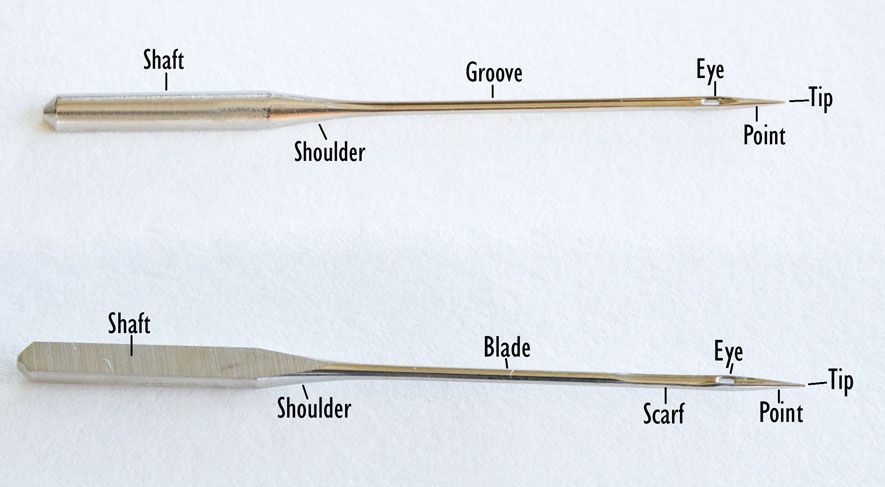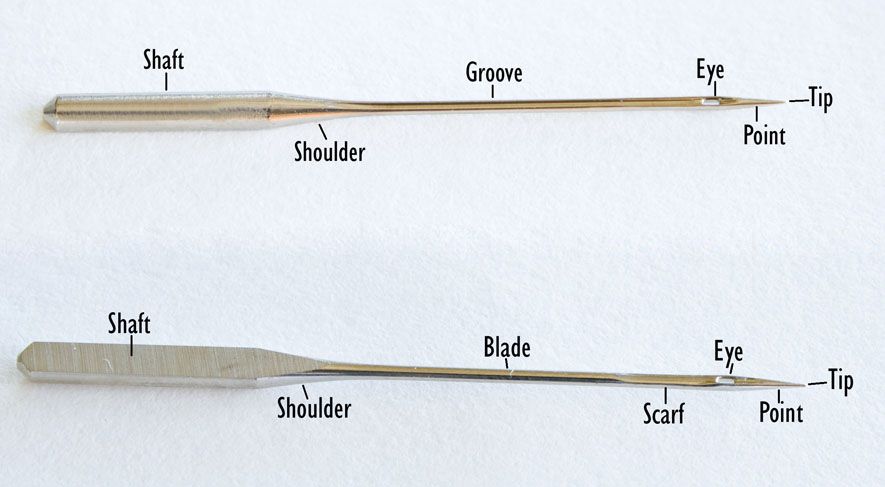
When I first began sewing, I underestimated the importance of proper sewing needle use. I figured I could use the needle that came with my machine for all projects until it broke, right? Wrong! Using the correct needle and frequently changing the needle makes ALL the difference. Think of it like this, you wouldn't use a wrench to hammer in a nail. It's not the proper tool for the job. Sewing machine needles are the same way. You need to match the needle with the project. As with any other tool, sewing needles will eventually wear out. The rule of thumb is to change your needle every 4 to 8 hours of sewing. For great quality needles, you may be able to go longer. For poor quality, best to change every project.
Personally, I don't keep a timer on my needles, so I pay more attention to how it sews. For instance, if I see skipped stitches, bunching, snagging, or anything other than a perfect stitch, I'll change the needle. Knowing you are using the correct needle is just one less variable to worry about.
Let's get to know what kind of needles are out there.

Universal - The point is slightly rounded for knits, but sharp enough to pierce wovens. Although a Universal needle can technically be used on knits, I've found it to be most effective with wovens, especially cotton.

Ballpoint - The choice needle for knits. It's rounded slightly to pass between the fabric threads rather than pierce them. Works well on heavy knits as well and won't damage spandex.

Quilting - The tapered point is designed for thick layers and intersecting seams. This is the best choice for perfect machine quilting. Quilting Needles can also be used for piecing.

Sharp - This needle has a sharp point and narrow shaft for piercing wovens. Works best on finely woven fabric like chintz, silk, light weight faux suede, and micofiber. Also great for heirloom sewing or any other type of topstitching.

Leather - This wedge shaped point is idea for sewing leather, suede, vinyl, heavy faux suede, and thick non-woven fabric. Pay close attention to where you sew; this needle will leave permanent holes. To avoid perforating the fabric, do not backstitch. Instead, tie the thread ends. Not for use with knits.

Denim - Denim Needles have a sharp point and strong shaft. These needles can stitch through many layers without breaking. Use on heavy, tightly woven fabric, like denim, canvas, and duck.

Topstitching - The extra large eye, large groove, and sharp point make it perfect for heavy decorative threads, like embroidery thread, or 2even two strands of all purpose thread. Use this needle anytime you have stitches visible on the outside of your project for a neat, clean look.

Stretch - Stretch Needles are designed for fine, light weight knits. Use when sewing Silk Jersey, Lycra, or anything with high elasticity. If you experience skipped stitches will a ballpoint needle, switch to a stretch needle.

Serger - These durable needles are specifically designed for Overlock machines. The sharp point gives it versatility for use on all fabrics. These needles are sized differently than conventional sewing machine needles. Check your manual for the correct needle. Change your serger needle after 15 hours of serging.

Embroidery - These are great machine embroidery and when sewing with Rayon, Acrylic, or specialty threads. The scarf of the needle protects the thread from fraying or breaking during high speeds.

Metallic - Monofilament and metallic thread work best with this needle because of the extra large eye. large groove scarf, and sharp point. This needle must be used when sewing metallic thread.

Wing - Just as in the name, it has flared 'wings' on each side of the shaft. Great for heirloom and decorative stitches, especially for batiste and linen. Some heirloom stitching can only be accomplished properly with a Winged Needle.

Twin - This 'needle' has a single shaft connecting two needles. This is often used when a sewist wants two perfectly matching stitches, commonly seam on jeans and decorative stitching. The users sewing machine must be twin needle capable, as you need two separate thread spools. Available in Denim, Stretch, Embroidery, Metallic, and Universal. Can also have one Winged needle and the other Universal.

Triple - This needle only comes as a universal needle. Just like the Twin needle, the Triple needle has a single shaft connecting three needles. Machine must be Triple needle capable.

Spring - This needle is most commonly used for free motion sewing, embroidery, and monogramming. the wire coiled shaft acts as a presser foot to depress and release the fabric. Only available in universal, stretch, and quilting.
Self Threading - This is a general purpose needle just like the universal, however the eye is enlarged to assist sewists whom have difficulty threading needles.
Understanding the Sizes
So you're ready to purchase your needles, but what do the numbers mean? There are two sizes, the American size and the European size with a '/' separating the numbers. The larger number is European sizing and the smaller number is American sizing. The size needle you need depends on the weight of your fabric. Think of it like this, a size 70/10 needle is for fine fabrics and the strength or the shaft and point are designed as such. If you use a 70/10 needle to sew two pieces of denim, chances are that needle will be out of service very quickly. Let's look at some general guidelines:
60/8 - For the most lightweight fabrics, like Organza, Chiffon, or Georgette.
70/10 - Light weight polyester or Silk, like you would use on a light blouse.
80/12 - Most Commonly Used - Cotton, Rayon, blends.
90/14 - Mid-heavy fabrics, like Corduroy, raw Silks, bottom weight fabric.
100/16 - Heavy fabrics, like Denim and Duck Cloth.
110/18 - For Very Heavy Fabric, like Canvas or tapestry.
120/19 - Heaviest Fabrics, like luggage handles and boat canvas.
Not sure about the right needle for your project? Leave us a message in the comment section below and we'll help you find it!
























